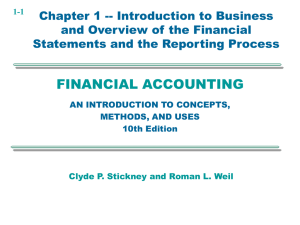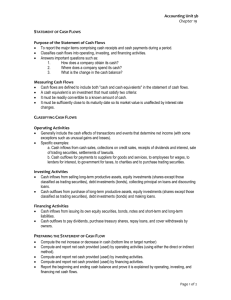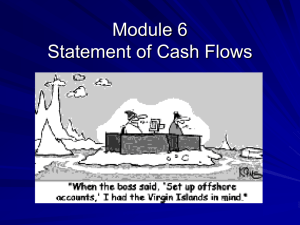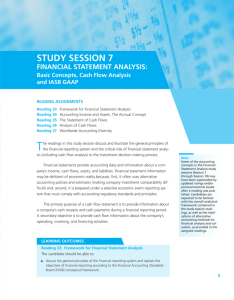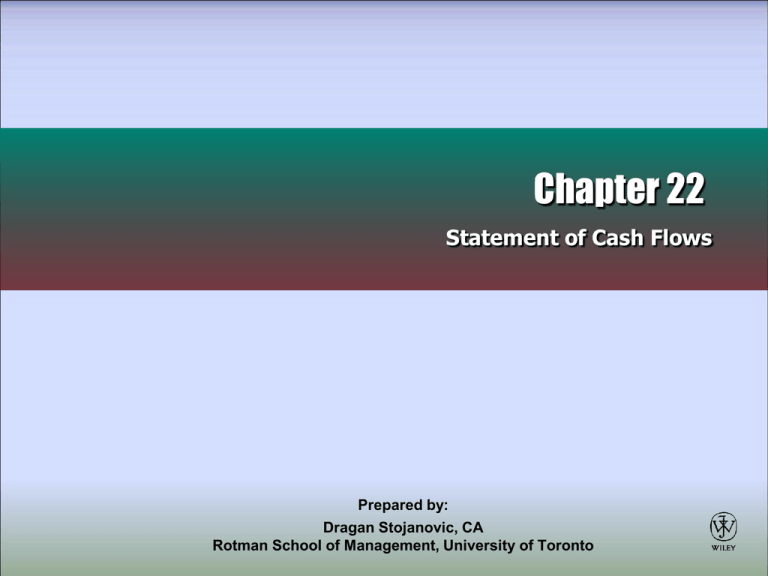
Chapter 22
Statement of Cash Flows
Prepared by:
Dragan Stojanovic, CA
Rotman School of Management, University of Toronto
Statement of Cash Flows
Introduction to
the Statement of
Cash Flows
•Usefulness of
the statement
•What is cash?
•Classification of
cash flows
•Format of the
statement
Preparing a
Statement of Cash
Flows
•Sources of
information
•Steps in the process
•First illustration –
Tax Consultants Inc.
•Second illustration –
Eastern Window
Products Limited
•Third illustration –
Yoshi Corporation
Presentation,
Disclosure, and
Analysis
•Disclosure
requirements
•Presentation
•Illustrative
examples
•Interpreting the
statement of cash
flows
•Free cash flow
IFRS/Private
Enterprise
GAAP
Comparison
•Comparison
of IFRS and
private
enterprise
GAAP
•Looking
ahead
2
Statement of Cash Flows
Introduction to
the Statement of
Cash Flows
•Usefulness of
the statement
•What is cash?
•Classification of
cash flows
•Format of the
statement
Preparing a
Statement of Cash
Flows
•Sources of
information
•Steps in the process
•First illustration –
Tax Consultants Inc.
•Second illustration –
Eastern Window
Products Limited
•Third illustration –
Yoshi Corporation
Presentation,
Disclosure, and
Analysis
•Disclosure
requirements
•Presentation
•Illustrative
examples
•Interpreting the
statement of cash
flows
•Free cash flow
IFRS/Private
Enterprise
GAAP
Comparison
•Comparison
of IFRS and
private
enterprise
GAAP
•Looking
ahead
3
Usefulness of the
Statement of Cash Flows
•
The information may help users (investors,
creditors, and others) assess the following:
1. Liquidity and solvency – i.e. the entity’s
ability to generate future cash flows and
its needs for cash resources
2. The amounts, timing, and uncertainty of
future cash flows
3. The reasons why net income and net cash
flow from operating activities differ
4
Cash and Cash Equivalents
Cash
• Cash on hand
• Demand deposits
All references to Cash
include Cash Equivalents
when discussing the
Statement of Cash Flows
Cash Equivalents
• Investments that are
– Short term,
– Highly liquid, and
– Easily converted to a
known amount of cash
– Subject to an
insignificant risk of
change in value
5
The Cash Flow Statement
•
The cash flow statement provides
information about:
• the cash receipts (cash inflows), and
• uses of cash (cash outflows) during the
year
•
Inflows and outflows are reported for:
• operating activities
• investing activities, and
• financing activities during the year
6
Cash Flow Classifications
1.
Operating Activities
• The cash flows resulting from the primary revenueproducing activities of the business, such as
•
•
•
•
•
Collections from customers
Payments to suppliers
Payments to employees
Payments to CRA for tax
Cash flow provided by operating activities
necessary for long term sustainability of the
business (i.e. to take advantage of new investment
opportunities, to pay dividends without seeking
external financing etc.)
7
Cash Flow Classifications
2. Investing Activities
•
•
•
The acquisition and disposal of long term
assets and long-term investments
Examples include:
• Purchase/disposal of capital assets
• Acquiring an interest in another
corporation
Cash flow generated by investing activities
shows if the business is investing in
additional long term assets that will generate
profits and increase cash flows in the future
8
Cash Flow Classifications
3. Financing Activities
•
•
•
Changes in long-term debt or equity capital
Examples include:
• Issuing debt, or repayment of debt
• Issuing new shares, or repurchase of
currently outstanding shares
Provides information to assess potential for
future claims to entity’s cash, extent of debt
and increased interest charges
9
Statement of Cash Flows:
Concept
Operating
activities
Inflows
Investing
activities
Financing
activities
Cash
Pool
Operating
activities
Investing
activities
Outflows
Financing
activities
10
Classification of Cash Flows
-
-
IFRS requirements relating to classification of cash flows are
similar to accounting standards for private enterprises (ASPE)
Under ASPE, interest and dividends included in determining
net income are classified as operating flows while those
charged against retained earnings are reported as financing
flows
Under IFRS, a choice is allowed for interest and dividends
Interest and dividends (paid and received) could be
classified as operating flows
Interest and dividends paid could also be classified as
financing outflow
Interest and dividends received could also be considered
investment flows
11
Significant Noncash Transactions
• Transactions that do not involve the direct
receipt or disbursement of cash in the period
• Examples:
– Asset purchased, paid for by assuming
debt, or issuance of shares
– Exchanges of non-monetary assets
– Conversion of debt to equity
• Noncash transactions are not reported on the
Statement of Cash Flows
• If material, they are reported as notes to the
statement or in a supplementary schedule to
the financial statements
12
Preparing a
Statement of Cash Flows
•
Two methods of preparing the operating cash
flow section of the Statement of Cash Flows:
1. Indirect method
2. Direct method
• Indirect method derives operating cash flows
from accrual basis income statement
• Direct method determines operating cash
flows directly for each operating source or use
of cash
13
In favour of Direct Method
• Is more consistent with objective of a
statement of cash flows
• Knowing specific sources of cash inflows and
purposes of cash outflows helps in estimating
future cash flows
• Lending officers and other investors prefer
direct method
• Both IFRS and PE GAAP encourage the use
of direct method as it provides additional
information
14
Cash Flow from Operations:
Indirect Method – Concept
Earned
Revenues
+
Net Income
Expenses
Incurred
-
Eliminate
non-cash revenues
Operating
cash flow
Eliminate
non-cash charges
15
The Statement of Cash Flows:
Indirect Method
Accrual Basis Statements
Cash Flow Statement
Income Statement items
and changes in Current
Assets and Current Liabilities
Operating activities:
Adjust net income for accruals,
non-cash charges and nonoperating gains/losses
Balance Sheet:
Changes in
Non-Current Assets
Investing activities:
Inflows from sale of assets and
outflows for purchases of assets
Balance Sheet:
Changes in Non-Current
Liabilities and Equity
Financing activities:
Inflows and outflows from loan
and equity transactions
16
Format of the Statement of
Cash Flows (Indirect Method)
Cash flows from operating activities:
Net Income (Loss)
Adjustments (List individual adjustments)
Net cash flow from operating activities
$ XXX
$ XX
$ XXX
Cash flows from investing activities:
(List individual inflows and outflows)
Net cash flow from investing activities
$ XX
$ XXX
Cash flows from financing activities:
(List individual inflows and outflows)
Net cash flow from financing activities
$ XX
$ XXX
Change in cash
$ XXX
17
Format of the Statement of Cash
Flows (Direct Method)
Cash flows from operating activities:
Cash receipts (individually): Inflows
Cash payments (separately): outflows
Net cash flow from operating activities
$ XXX
($ XXX)
$ XXX
Cash flows from investing activities:
(List individual inflows and outflows)
Net cash flow from investing activities
$ XX
$ XXX
Cash flows from financing activities:
(List individual inflows and outflows)
Net cash flow from financing activities
$ XX
$ XXX
Change in cash
$ XXX
18
Cash Flows from Operations: Direct
Method
Inflows
• Received from
customers for cash
sales and on
account
• Cash receipts from
other revenue
sources
Outflows
• To suppliers for cash
purchases and
payments on account
• To employees for
salaries and wages paid
• To government for taxes
paid
19
Statement of Cash Flows
Introduction to
the Statement of
Cash Flows
•Usefulness of
the statement
•What is cash?
•Classification of
cash flows
•Format of the
statement
Preparing a
Statement of Cash
Flows
•Sources of
information
•Steps in the process
•First illustration –
Tax Consultants Inc.
•Second illustration –
Eastern Window
Products Limited
•Third illustration –
Yoshi Corporation
Presentation,
Disclosure, and
Analysis
•Disclosure
requirements
•Presentation
•Illustrative
examples
•Interpreting the
statement of cash
flows
•Free cash flow
IFRS/Private
Enterprise
GAAP
Comparison
•Comparison
of IFRS and
private
enterprise
GAAP
•Looking
ahead
20
Indirect Method: Example
Tax Consultants Inc. began operations on January 1, 2011.
The income statement and balance sheet for year 2011 follow.
Income Statement
Revenues
Less: Operating expenses
Income before Tax
Less: Income Tax
Net Income
$ 125,000
85,000
40,000
6,000
$ 34,000
A dividend of $14,000 was declared during year.
21
Indirect Method: Example
Balance Sheet
Dec 31, 2011 Jan 1, 2011
Assets:
Cash
Accounts Receivable
Total
$ 49,000
36,000
$ 85,000
$-0-0$-0-
Liabilities and Shareholders’ Equity:
Accounts Payable
$ 5,000
Common Shares
60,000
Retained Earnings
20,000
Total
$85,000
$-0-0-0$-022
Operating Activities
Accrual Basis
Net Income
$34,000
Accounts Receivable +$ 36,000
Accounts Payable
+$ 5,000
Changes between beginning
and ending balances
Cash Flow
Net Income
$34,000
Less: Increase in A/R
Add: Increase in A/P
$ 36,000
$ 5,000
Operations: Net Inflow $3,000
See explanations next slide
23
Operating Activities
Accounts Receivable
Increased by $36,000
Cash collections are
less than revenue
recognized
Reduce net income
by $36,000 to derive
cash flows from
operations
24
Operating Activities
Accounts Payable
Increased by $5,000
Cash paid for purchases
is less than expenses
reported
Increase net income
by $5,000 to derive
cash flows from
Operations; net
income for the year
increases by $5,000
25
Investing and
Financing Activities
Accrual Basis
Common Stock + $60,000
Retained Earnings +
$20,000
Cash Flow
Financing Activities:
Issue of Shares: $60,000
Dividends paid: ( 14,000)
Inflow
46,000
Beg Bal:
$
0
Net Income:
34,000
less: Dividends (14,000)
End Balance: $20,000
26
Cash Flow Statement:
(Indirect Method) - Summary
• Cash provided by operating activities: $ 3,000
• Cash used by investing activities:
-0-
• Cash provided by financing activities:
• Net inflow for the year
• Beginning cash balance:
• Cash, end of year
46,000
$ 49,000
$
-0$ 49,000
27
Other Items
• Income statement gains and losses on disposal
of long-term assets must be adjusted in
determining cash from operations. Why?
• These result from investing activities, not
operating activities and
• The amount of the cash flow is the proceeds on
disposal, not the gain or loss
28
Other Items
• Income statement gains and losses on
redemption of long-term debts must be adjusted
in determining cash from operations. Why?
• These result from financing activities, not
operating activities and
• The amount of the cash flow is the amount paid
to redeem the debt, not the gain or loss
29
Cash From Operations: Direct
Method
Refer to Tax Consultant Inc. the data for the indirect method.
Cash receipts from customers:
= Revenue from credit sales – Increase in A/R balances
= $125,000 – $36,000 = $89,000
Cash payments to suppliers:
= cost of goods sold
= $85,000 – $5,000 = $80,000
30
Direct Method:
Operating Activities
Operating Activities:
Cash receipts from customers
Cash paid to suppliers
Cash paid for income taxes
Net cash inflow
$ 89000
(80,000)
(6,000)
$ 3,000
31
Statement of Cash Flows
Introduction to
the Statement of
Cash Flows
•Usefulness of
the statement
•What is cash?
•Classification of
cash flows
•Format of the
statement
Preparing a
Statement of Cash
Flows
•Sources of
information
•Steps in the process
•First illustration –
Tax Consultants Inc.
•Second illustration –
Eastern Window
Products Limited
•Third illustration –
Yoshi Corporation
Presentation,
Disclosure, and
Analysis
•Disclosure
requirements
•Presentation
•Illustrative
examples
•Interpreting the
statement of cash
flows
•Free cash flow
IFRS/Private
Enterprise
GAAP
Comparison
•Comparison
of IFRS and
private
enterprise
GAAP
•Looking
ahead
32
Disclosure Requirements
•
•
IFRS and PE GAAP require similar disclosures on certain
items, including the disclosure of:
1. Significant non-cash investing and financing
transactions
2. Policy on what makes up cash and cash equivalents
3. Reconciliation of cash and cash equivalents to
balance sheet accounts
IFRS has more strict requirements relating to disclosure
of some items, including:
1. Income taxes
2. Interest and dividends (paid and received)
3. Restrictions on cash and cash equivalents
33
Free Cash Flow
• Free cash flow (FCF) is a non-GAAP measure
used by many companies to indicate
discretionary cash available for new investments,
paying dividends, retiring debt, repurchasing
shares, or improving liquidity
• FCF is typically calculated as
– Net operating cash flows
– Less: capital expenditures to sustain current level
operations
• As it is a non-GAAP measure, some companies
calculate FCF differently
34
Statement of Cash Flows
Introduction to
the Statement of
Cash Flows
•Usefulness of
the statement
•What is cash?
•Classification of
cash flows
•Format of the
statement
Preparing a
Statement of Cash
Flows
•Sources of
information
•Steps in the process
•First illustration –
Tax Consultants Inc.
•Second illustration –
Eastern Window
Products Limited
•Third illustration –
Yoshi Corporation
Presentation,
Disclosure, and
Analysis
•Disclosure
requirements
•Presentation
•Illustrative
examples
•Interpreting the
statement of cash
flows
•Free cash flow
IFRS/Private
Enterprise
GAAP
Comparison
•Comparison
of IFRS and
private
enterprise
GAAP
•Looking
ahead
35
Looking Ahead
• Significant changes are expected from the
FASB-IASB Financial Statement Presentation
project
• Both IAS 1 Presentation of Financial
Statements and IAS 7 Statement of Cash
Flows are expected to be replaced with a new
standard
36
COPYRIGHT
Copyright © 2010 John Wiley & Sons Canada, Ltd.
All rights reserved. Reproduction or translation of
this work beyond that permitted by Access Copyright
(The Canadian Copyright Licensing Agency) is
unlawful. Requests for further information should be
addressed to the Permissions Department, John
Wiley & Sons Canada, Ltd. The purchaser may make
back-up copies for his or her own use only and not
for distribution or resale. The author and the
publisher assume no responsibility for errors,
omissions, or damages caused by the use of these
programs or from the use of the information
contained herein.
37


